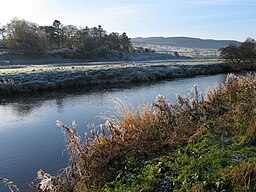Coquetdale
| River Coquet | |
|
River Coquet near Rothbury
|
|
| Country | United Kingdom |
|---|---|
| County | Northumberland |
| Source | |
| - coordinates | 55°22′05″N 2°20′53″W / 55.368°N 2.348°W |
| Mouth | |
| - location | Amble |
| - coordinates | 55°20′21″N 1°34′18″W / 55.3393°N 1.5718°WCoordinates: 55°20′21″N 1°34′18″W / 55.3393°N 1.5718°W |
| Basin | 625 km2 (241 sq mi) |
| Discharge | for Morwick |
| - average | 8.7 m3/s (307 cu ft/s) |
The River Coquet /ˈkoʊkət/ runs through the county of Northumberland, England, discharging into the North Sea on the east coast of England at Amble. Warkworth Castle is built in a loop of the Coquet.
The river, about 40 miles (64 km) in length, rises in the Cheviot Hills and follows a course generally easterly, but greatly winding. It passes Harbottle, near which relics of the Stone Age are seen, and Holystone, where it is recorded that Bishop Paulinus baptized a great body of Northumbrians in the year 627. Several earthworks crown hills above this part of the valley and at Cartington, Tosson and Whitton are relics of medieval border fortifications.
The small town of Rothbury is situated beneath the rugged Simonside Hills. The river dashes through a narrow gully called the Thrum, and then passes Brinkburn Priory, of which the fine Transitional Norman church was restored to use in 1858, while there are fragments of the monastic buildings. This was an Augustinian foundation of the time of Henry I.
A short distance below this the Coquet has its mouth in Warkworth Harbour, with the small port of Amble on the south bank, and Coquet Island a mile out to sea. The river is frequented by sportsmen for salmon and trout fishing. No important tributary is received, but ten smaller tributaries do join the river at intervals, including Usway Burn and the River Alwin.
...
Wikipedia

